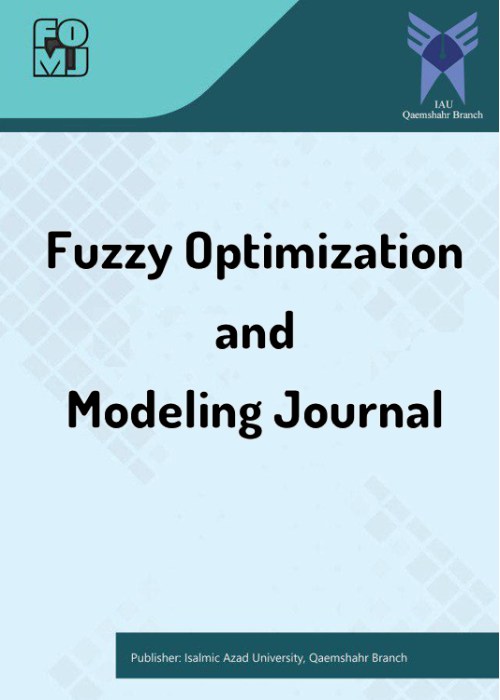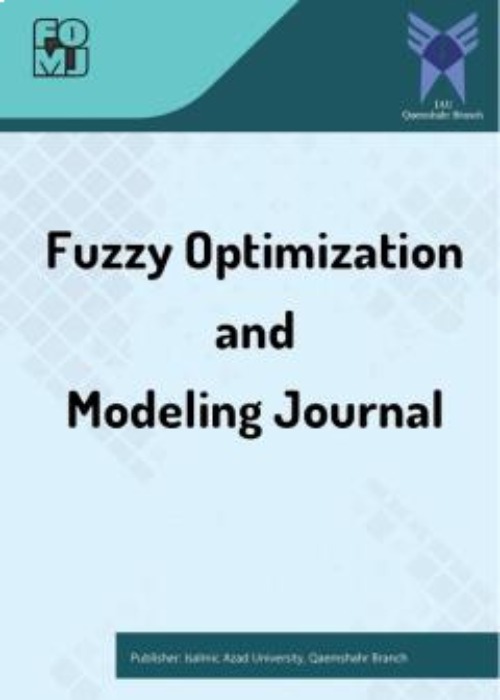فهرست مطالب

Fuzzy Optimzation and Modeling
Volume:4 Issue: 3, Summer 2023
- تاریخ انتشار: 1402/08/29
- تعداد عناوین: 5
-
-
Pages 1-15The literature of linear programming problem with trapezoidal intuitionistic parameters is full of solution approaches which are mainly ranking function based. Use of ranking function in the solution approaches could be a weakness as different ranking functions mag give different solutions. This paper, proposes a new solution approach without any ranking function for linear programming problem with trapezoidal intuitionistic parameters. For this aim, the trapezoidal intuitionistic fuzzy objective function is converted to a multi-objective function, and consequently, the problem is converted to a multi-objective crisp problem. As another contribution, in order to solve the obtained multi-objective problem for its efficient solutions, a new multi-objective optimization approach was developed and suited to the obtained multi-objective problem. The computational experiments of the study show the superiority of the proposed multi-objective optimization approach over the multi-objective optimization approaches of the literature.Keywords: linear programming, Trapezoidal intuitionistic fuzzy number, Multi-Objective Optimization, Fuzzy programming approach
-
Pages 16-33This study endeavours to present an innovative prognostic framework and evaluate the future prospects of strategic cooperation between fin-tech startups and the banking sector in Iran. Employing a descriptive survey approach, extensive research was conducted through comprehensive literature reviews, field investigations, and insights gathered from interviews and questionnaires administered to 14 experts affiliated with both financial institutions and fin-tech companies. By identifying six key factors encompassing 31 unique indicators, including motivations for strategic cooperation, effective factors on cooperation, diverse levels of cooperation, external organizational factors, and barriers to strategic cooperation, and outcomes of strategic cooperation, a comprehensive conceptual model was developed. Employing advanced fuzzy inference techniques and MATLAB software, this model was employed to meticulously evaluate the viability and efficacy of strategic cooperation within the banking sector and fin-tech startups. The findings underscore the paramount significance of barriers to strategic cooperation while emphasizing the vital role of external organizational factors, effective factors on cooperation, diverse levels of cooperation, outcomes of strategic cooperation, and motivations for strategic cooperation of banking institutions and fin-tech startups. Additionally, the study gauges the level of strategic cooperation between the banking system and fin-tech startups, which yielded a commendable rating of 7.06, signifying a substantial medium-to-high range. Furthermore, the designed model showcases remarkable validation and predictive capabilities, rendering it an invaluable tool for forecasting future cooperation scenarios.Keywords: Financial Ecosystem, Fintech Start-ups, Strategic Cooperation, Banking system
-
Pages 34-39Zadeh extended in 1965 crisp sets to the concept of fuzzy set (FS) on the purpose of tackling mathematically the partial truths and the definitions with no clear boundaries. In a later stage FSs were extensively used for tackling the existing in the real world uncertainty. Neutrosophic sets (NSs) are extensions of FSs in which each element of the universal set is characterized, apart from Zadeh’s membership degree, by the degrees of non-membership and indeterminacy. Grey numbers (GNs) are real numbers with known range, represented by a closed real interval, but with unknown exact value. GNs and NSs are used in this paper as tools for assessment processes under fuzzy conditions. The use of GNs enables the evaluation of the mean performance of a group of objects when qualitative grades (linguistic expressions) are used for the individual assessment of its members. The use of NSs, on the other hand, is useful for assessing the overall performance of a group, when one, due to incomplete assessment data, is not sure about the exactness of the grades assigned to its members. It is concluded that the suitable combination of two or more theories related to FSs give better assessment outcomes in general. Examples are also presented on student assessment illustrating our results.Keywords: fuzzy set, Neutrosophic set, Grey system, Grey Number, Assessment under Fuzzy Conditions
-
Pages 40-53In the bank-oriented country of Iran, banks hold a crucial role as the primary financial markets. They provide vital support to businesses and offer financial assistance to other institutions. To ensure efficiency and achieve their goals, it is important to Continuous evaluate the financial performance of these banks. This research aims to identify and rank the indicators that are effective in evaluating the financial performance of private banks, using the fuzzy AHP method. This research has been conducted with a mixed approach, which is applied in terms of purpose and descriptive Survey in nature and has been conducted with a mixed approach. The statistical population for this study consists of managers and assistants from private banks, selected using the snowball method. The qualitative part of the research employed the grounded theory approach developed by Strauss and Corbin to identify relevant indicators, while the quantitative part involved ranking these indicators using the fuzzy AHP approach. The results indicate that eight indicators, including capital structure, management efficiency, asset management, operating profit, liquidity, cost, profitability, and income, significantly influence the evaluation of financial performance. This study provides valuable insights to private bank managers, assisting them in identifying important indicators for evaluating their bank's financial performance and improving efficiency accordingly.Keywords: Financial Performance, Fuzzy AHP, financial indicators, Banks
-
Pages 54-71
Human resource productivity is one of the main concerns in organizations. In total,100 factors According to on three main sources: 1- Opinions of experts and academic professors, 2- Using project technical documents, 3- Previous similar research studies and related scientific sources, were identified and categorized into four groups: plan human resource management, acquire project team, develop project team, and manage project team. Questionnaires were distributed among 103 members of the target population who were active construction contractors in Iran. The questionnaires were analyzed using two methods Relative Importance Index (RII) and the Fuzzy Logic (FL). Ten factors that had the highest impact, based on the two methods, on HRP efficiency in the projects were identified and compared. The results of fuzzy logic and RII method showed that both methods were highly similar in terms of outcomes. In addition, the results indicated that “lack of proper communication between the technical office and workshop” was the most important factor based on the two techniques mentioned.
Keywords: human resource productivity, urban construction, Relative Importance Index, fuzzy logic


